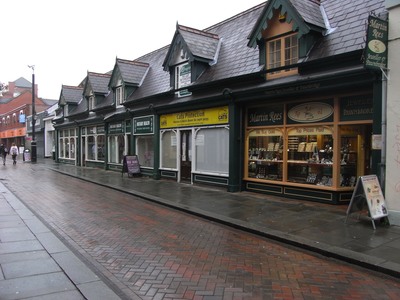The Shop's History
 Above Chester Street, our shop in the foreground.
Above Chester Street, our shop in the foreground.
Below same view in the 1980s.


Inside, 17th Century beams, and 21st Century shopfittings
Built in the 17th
Century, converted into shops in the 19th and modernised in the
20th Century. They still look similar to the original workshops,
and are small compared to the later buildings around them.
The shop was built during the reign of Charles II (1660-85)
as an oak framed building.
None of the shops in our block have a chimney, so they were
probably built as workshops, however until the 19th century some
Welsh houses lacked chimneys, so we can't be certain.
During the 19th Century, all 5 workshops were converted into
shops. staircases were added to the end properties, also dormer windows were installed.
Our shop uses the upstairs area as a workshop. The other end shop used the rest of
the upstairs area as a tearoom.
The 1865 Ordnance Survey map
clearly shows the buildings have the same general floorplan as
today, although there were more workshops behind them.
The family which then owned the whole block are still our
landlords.
Dormer windows were installed, then guttering was placed in front of them, so
they couldn't be opened!
About 1910 our shop was altered and became a jewellers. It was
originally owned by Mr Francis, who passed it over to Mr Mawdsley
around 1940, who remained the tenant until 1985, when he finally
decided to retire at the ripe old age of 82. After enjoying some
years of healthy retirement,
he died in January 1997.
By the time the shop was ours, the whole block was very
dilapidated, the tenants had not maintained the property. I still remember the day a slate
fell off the roof straight onto a passing police car!
Eventually the shops were renovated. Ours posed an interesting
problem, because the safe had been installed and the
building's brickwork altered afterwards - so it was
impossible to move the safe, and all the work had to done around
it. Our shop still has plenty of character, which means walls and
ceilings are uneven! We have an oak beam across the ceiling, and
exposed beams in our workshop.

